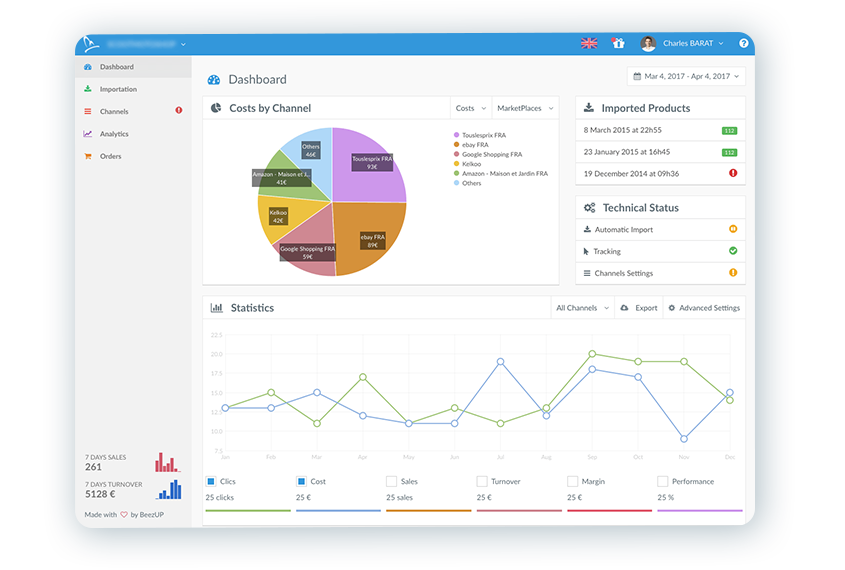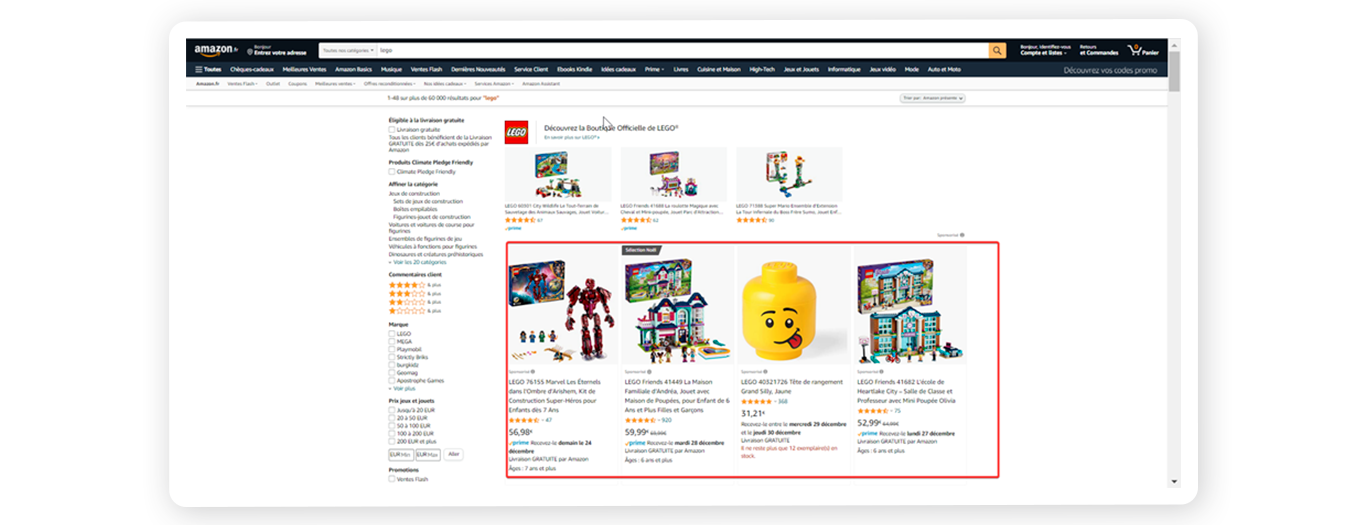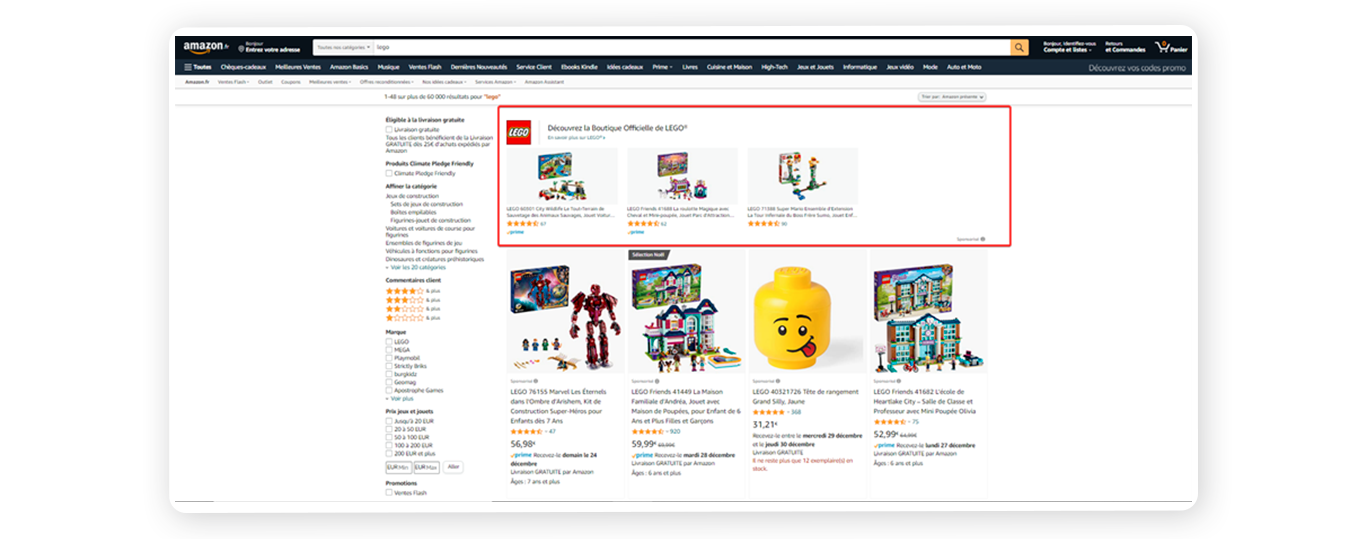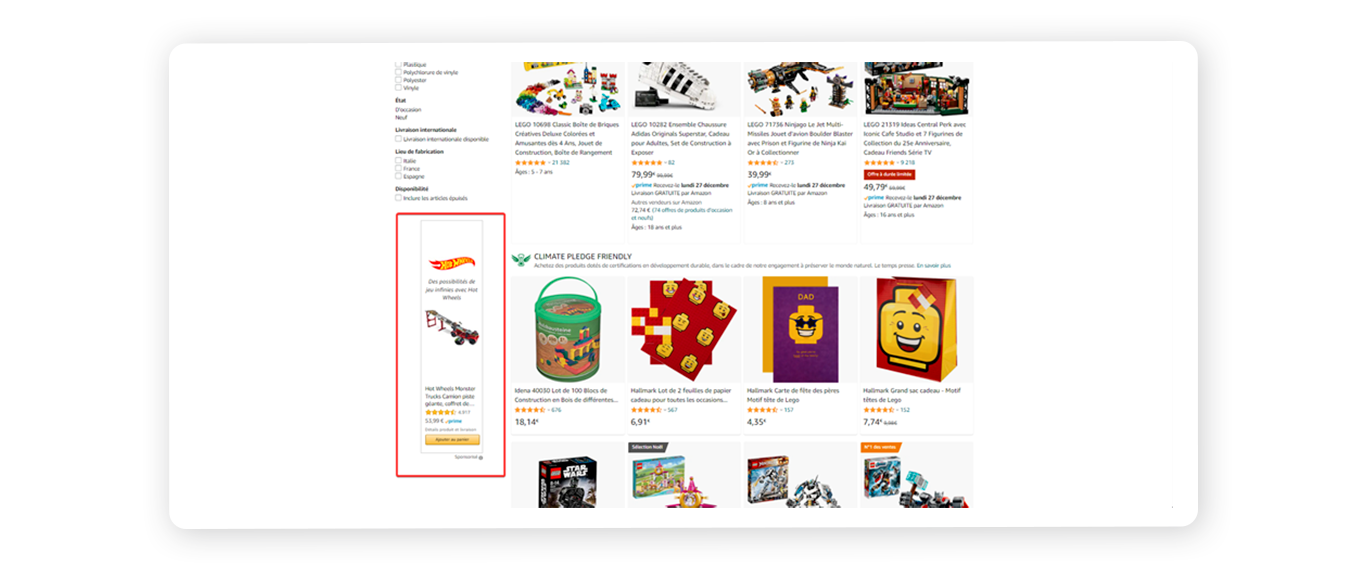Sell on marketplaces, yes, but not without a sales strategy! And a strategy means having clear and measurable e-commerce objectives.
So you need to measure the performance of the actions implemented using relevant, reliable performance indicators at each stage of your purchasing process: these, of course, are KPIs (key performance indicators)
… Otherwise, how do you know whether a marketplace is profitable, whether one product is selling better than another or whether your sponsoring tools have generated sales?
In order to avoid drowning in a sea of data, which is very likely with a multi-marketplace strategy, let’s define what a KPI is. Which are the most relevant ones for steering your sales strategy on marketplaces? And how can we track them effectively as a team?
SUMMARY
1. What is a KPI?
Before getting to the heart of the matter, we remind you that KPIs are quantifiable and measurable indicators that can be compared over time, enabling you to make informed strategic decisions.
In the case in question, in marketplaces, they help you to evaluate the performance of your products and the fluidity of your e-commerce purchase path. They are essential for defining and tracking your business objectives.
OK, but there are almost as many KPIs as there are marketplaces (well, we’re exaggerating a little bit😅)! That’s why selecting the right ones is important.
Just as important, your team must be aware of the KPIs selected and understand their usefulness, especially since they are able to participate in their tracking.
Today, marketplaces, analytics tools and e-commerce feed managers are capable of measuring just about everything. To help you sort through the list, we have selected the essential marketplace KPIs per broad category of action.
2. Marketplace KPIs for measuring your online sales strategy
a. KPIs for tracking your overall activity on the marketplace(s)
Common to all e-commerce managers, marketplace KPIs provide an overview of the health of your sales on them. They allow you to detect any anomalies in order to rectify them, but also to find out which platforms are the most profitable and to identify potential opportunities……
How can you track them?
Via your seller space on each marketplace or via a product feed management software such as BeezUP, which centralises the main KPIs for tracking your sales, turnover, cost, margin and performance 😉

📊 Turnover per marketplace
Turnover is THE first KPI to track. It shows you the evolution of sales made on the marketplace and all the associated revenue generated.
📊 The number of orders
Checking the turnover is not enough. To get an overview, you need to link it to the number of orders. Indeed, you can have the same turnover with a different number of orders depending on the number of purchases made. Hence the importance of calculating the next KPI: average basket👇.
Not checking the number of orders could lead you awry, into failing to anticipate the replenishment of your stocks, for example.
Furthermore, a sharp increase or decrease in orders can be indicative of a failure. A price that is too low, for example, can generate an abnormal increase in the number of orders and make you lose a lot of money…
This indicator also allows you to evaluate the results of your sales and marketing operations, etc.
📊 Average basket
The average basket is the average amount spent per order placed by your customers. This KPI is to be evaluated according to the price of your products and your average basket, either in-store or in your online shop.
📊 Sales margin / profit margin per marketplace
This is a key indicator for evaluating the profitability of your sales on the marketplace, and is the difference between your selling price and the cost price.
To calculate this margin, you need to take into account the cost of the marketplace: the cost of the monthly subscription, the commission for your product category, the logistical costs (storage, transport, delivery), etc. For example, at BeezUP, our sellers set up their data per marketplace so that the cost and margin of each one are automatically displayed in their dashboard.
As you can see, the higher your margin, the more profitable the e-commerce platform is for your business!
📊 Shipping costs
As we have seen previously, shipping costs have an impact on your sales margin. It is therefore important to take them into account, especially as they are a variable.
Indeed, if you sell your products internationally, shipping costs will automatically vary depending on the country and your logistics provider.
The use of fulfilment services offered by marketplaces, such as Fulfillment By Amazon (FBA), can also have an impact on your margin. So this is a KPI you should pay close attention to.
📊 Business volume (GMV)
Business volume or GMV (Gross Merchandise Volume) includes merchandise sales, other revenues and the business volume of the marketplace based on confirmed and shipped orders. It differs from turnover in that it does not include delivery costs, discounts and product returns.
📊 Time to add or update a product
This is a KPI that you may not consider, yet it is a key indicator for you and your team.
As a seller on marketplaces, you know they have their own requirements for structuring the product catalogue. This step can be very time-consuming depending on the method used and can therefore impact your profit: non-publication of the product, labour costs, impact on your internal organisation, etc.
There are several options available to you:
- Create your product files manually and directly on the marketplace, which allows you to obtain detailed files, but remains tedious and time-consuming…
- Import your product catalogue manually via a file (Excel, XML, etc.) on each marketplace, adapting it to the format required by each marketplace.
- Use a marketplace feed manager like BeezUP to automate and centralise the management of your e-commerce feeds. This allows you to import your product feed once, to adapt and enrich it without touching your source catalogue. And, at the same time, to receive the order feedback directly in your online shop… 😀
b. KPIs to monitor to keep your seller account top-tier
In addition to the KPIs we have just seen, there are others to be tracked closely. The following indicators allow you to maintain a good evaluation of your seller account on marketplaces.
Indeed, marketplaces attach great importance to the buyer experience on their platform and set strict rules for sellers: SLAs.
So, to avoid potential penalties or unhappy customers, it is in your best interest to have your marketplace team regularly track these customer satisfaction indicators.
For greater efficiency, we recommend that you break down the KPIs according to the position held by and data available to each member of your team.
📊 Order acceptance time
This is the time you take to confirm an order received from the marketplace. This processing time takes into account all the time before the order is dispatched and can vary between 24 and 72 hours, depending on the platform. So you need to be very responsive!
In addition to this indicator, you also have an order acceptance rate to keep to. On Fnac, for example, sellers must maintain a minimum rate of 95% to avoid being penalised.
Our product feed management tool’s features, such as automatic order feedback, allow you to keep these indicators in the green😉.
📊 Shipping time
Shipping time is, as the name suggests, the time it takes you to ship the orders you receive.
However, it is not only the shipping time that is taken into account, but also the late shipping rate. Marketplaces set this rate at a maximum of 5% on average.
There are several ways to reduce this delay: use a marketplace integrator to centralise your orders and avoid repeated administrative steps, or fulfilment services (also compatible with our tool), which free you entirely or partially from logistics management and therefore reduce the shipping time of your orders.
📊 Order tracking
Order tracking is the time it takes you to send all the tracking information to your customer via the marketplace.
At BeezUP, we have developed features to ensure an optimal shopping experience. For example, our merchants can add the relay point identifier in the shipping fields, to inform their customer and obtain better tracking.
📊 Order cancellation rate
This is the percentage of cancelled orders out of all your orders on the marketplace.
On Amazon, for example, you must not exceed a cancellation rate of 2.5%.
The main cause of order cancellation is out-of-stock sales. Therefore, it is necessary to correlate this KPI with your stock tracking and to facilitate its management by using product feed management software.
📊 Message response time
This is the time you take to respond to your customers’ messages. And beware, the marketplaces attach as much importance to this as they do to order acceptance times or delivery times, for example!
Taking the example of Amazon, it requires its sellers to respond to more than 90% of your messages within 24 hours (including weekends and public holidays). Don’t forget that the end customer is king.
There are several varyingly practical and/or time-consuming ways to manage your marketplaces customer messages… For our part, we offer our merchants the opportunity to meet this SLA and avoid unhappy customers by using our “Conversations” feature. With it, their marketplaces customer messages are centralised and manageable from their BeezUP space.
📊 Incident rate, returns management & returns dissatisfaction rate
The incident rate refers to the problems that customers may encounter during their shopping experience on a marketplace (non-compliant product, shipping delay, etc.) and that may affect the user experience.
Once again, the penalties can come very quickly depending on the platform. The Boulanger marketplace, for example, automatically removes your products from its site if you have a rate of over 7%.
The returns dissatisfaction rate is the number of customers who are dissatisfied with the processing of their product return out of the total number of returns.
Again, our Conversations feature can help you reduce these rates by allowing you to respond to refund requests more quickly.
📊 Refund rate
This is the number of orders you refund out of the total number of orders. Taking Fnac as an example, its sellers must not exceed a rate of 5% or risk having their account suspended or deactivated.
c. KPIs for measuring the performance of your sponsorship campaigns on marketplaces
Do you use the sponsorship tools offered by marketplaces such as Cdiscount, Amazon, ManoMano, eBay or Rakuten? Then you are probably already tracking indicators to evaluate the performance of your Product Ads.
Measuring their results is indeed essential in order to focus your efforts on the best performing products and to avoid a loss-making investment on this lever. Here again, regular checking and debriefing with your team will allow you to correlate the data in order to better interpret it and adjust your strategy if necessary.
Here are some examples of sponsorship tools:
- Sponsored products

- Sponsored brands

- Display ads

Below are the main KPIs to track for your campaigns 👇🏼
📊 Number of impressions
The number of impressions is the number of times your ad is displayed and seen on the marketplace. The same user may see your ad several times. In this case, each view corresponds to an impression.
This KPI allows you to measure the visibility of your Product Ads. This indicator is also essential for calculating the CPT.
📊 Cost per thousand (CPM)
The CPT or cost per thousand refers to the cost per thousand impressions, i.e. the amount you pay when your ad is shown 1000 times.
📊 Cost per click (CPC)
The cost per click or CPC is the price you pay when the marketplace customer clicks on your sponsored ad. This payment model, often offered for several advertising solutions, allows you to pay only on performance.
📊 Conversion rate
This is one of the most important metrics to track, as it represents the effectiveness of your campaigns. The conversion rate is the percentage of customers who made a purchase after clicking on your ad.
📊 Cost per conversion
The cost per conversion is the amount you spent to convert a visitor into a customer. In this case, the conversion is the confirmation of the basket, i.e. a purchase on the marketplace after having clicked on your ad.
📊 Advertising spend
Advertising spend is the amount you spend per day on advertising and can be calculated per campaign, per keywords, etc.The amounts of these expenses will depend on your advertising strategy and mustn’t be higher than the turnover generated.
Here we have presented the main KPIs to be tracked by your e-commerce team, for e-merchants with a multi-marketplace sales strategy, international or otherwise.
As we have seen before, it is not a question of tracking all the performance indicators, but only those relevant to your marketplace activity.
To save time and for convenience, we recommend e-commerce managers opt for a product feed manager such as BeezUP, which is accessible to your entire team and allows centralised tracking of your marketplace KPIs.
In addition to simplifying the management of your e-commerce flows, our tool allows you to enhance your performance. Indeed, thanks to its dashboard, advanced statistics and customised and automated analysis reports, tracking the performance of your campaigns becomes child’s play with BeezUP!

Alix Oudin, Head of Marketing & Communication at BeezUP
Annabelle Granulant, Content Manager at BeezUP




